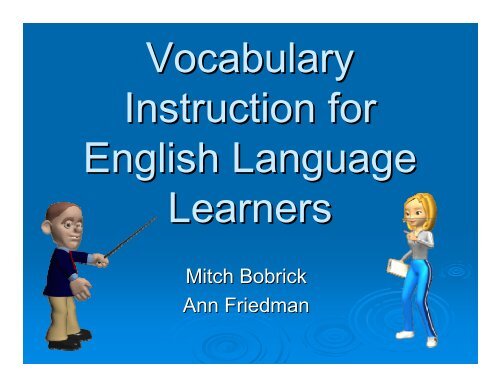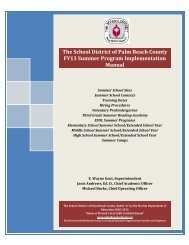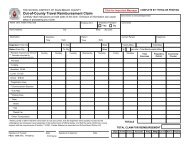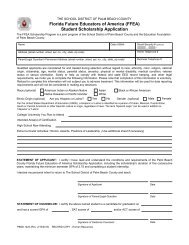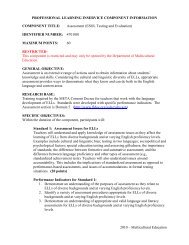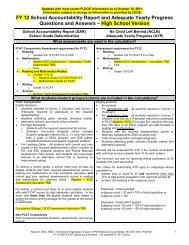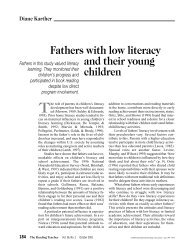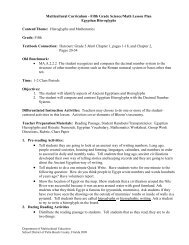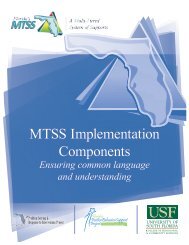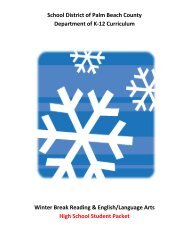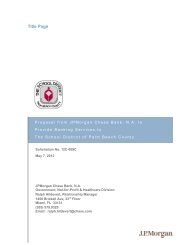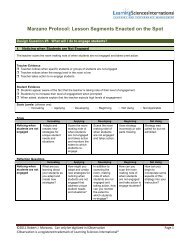Vocabulary Instruction for English Language Learners - The School ...
Vocabulary Instruction for English Language Learners - The School ...
Vocabulary Instruction for English Language Learners - The School ...
Create successful ePaper yourself
Turn your PDF publications into a flip-book with our unique Google optimized e-Paper software.
<strong>Vocabulary</strong><br />
<strong>Instruction</strong> <strong>for</strong><br />
<strong>English</strong> <strong>Language</strong><br />
<strong>Learners</strong><br />
Mitch Bobrick<br />
Ann Friedman
Academic <strong>Language</strong><br />
‣ <strong>Language</strong> used in the learning of<br />
academic content in <strong>for</strong>mal schooling<br />
context; aspects on language strongly<br />
associated with literacy and academic<br />
achievement, including specialized<br />
academic terms or technical language,<br />
speech registers, and discourse related to<br />
each field of study.
Essential Components of<br />
Academic <strong>Language</strong><br />
‣ <strong>Vocabulary</strong> – all the words that someone<br />
knows, learns, or uses<br />
‣ Syntax – the way words are arranged to<br />
<strong>for</strong>m sentences or phrases<br />
‣ Grammar – the rules according to which<br />
the words of a language change their <strong>for</strong>m<br />
and are combined into sentences
Academic Literacy<br />
Development<br />
Native <strong>English</strong>-Speaking<br />
“Struggling Readers”<br />
& ELLs are<br />
DIFFERENT<br />
A Starting Point <strong>for</strong> Understanding Some<br />
Challenges Faced by <strong>English</strong> <strong>Language</strong><br />
<strong>Learners</strong>
Six Indicators the Panel Studied & Compared<br />
Motivation<br />
Indicators<br />
Position on the<br />
path to literacy<br />
Oral <strong>English</strong> proficiency<br />
Background knowledge<br />
<strong>Vocabulary</strong> terms<br />
with multiple meanings<br />
Context in which literacy<br />
is developed<br />
Native<br />
<strong>English</strong>-Speaking<br />
“Struggling Readers”<br />
<strong>English</strong><br />
<strong>Language</strong><br />
<strong>Learners</strong><br />
(Short, D., & Fitzsimmons, 2007)
Indicator<br />
<strong>Vocabulary</strong><br />
terms with<br />
multiple<br />
meanings<br />
Native<br />
<strong>English</strong>-Speaking<br />
“Struggling Readers”<br />
More likely to recognize multiple<br />
meanings<br />
<strong>English</strong> <strong>Language</strong> <strong>Learners</strong><br />
May know one meaning of a word<br />
(power means strength, Cherokee<br />
is a large car), but not other<br />
meanings, including the one<br />
needed <strong>for</strong> a particular subject<br />
(political power, Cherokee tribe)<br />
Often have conceptual<br />
knowledge of term or concept, if<br />
not the technical or academic<br />
label<br />
May apply knowledge of cognates<br />
to understand new academic<br />
terms<br />
(Short, D., & Fitzsimmons, 2007)
Challenges<br />
‣ Only 4% of <strong>English</strong> <strong>Language</strong> <strong>Learners</strong>’<br />
day is spent engaging in <strong>English</strong> in<strong>for</strong>mal<br />
“student talk”!!!<br />
‣ Only 2% of <strong>English</strong> <strong>Language</strong> <strong>Learners</strong>’<br />
day is spent engaging in <strong>English</strong> in<strong>for</strong>mal<br />
“academic talk”!!!
Tier One:<br />
<strong>Vocabulary</strong> <strong>Instruction</strong><br />
A “Tier” Approach<br />
• the most basic words<br />
• clock, baby, happy<br />
Rarely require extensive instruction<br />
in school<br />
Beck, 2007
Tier Three:<br />
<strong>Vocabulary</strong> <strong>Instruction</strong><br />
• words whose frequency of use is<br />
quite low, often limited to specific<br />
domains<br />
• isotope, lathe, peninsula<br />
Best learned during content<br />
area instruction<br />
A “Tier” Approach<br />
Beck, 2007
Tier Two:<br />
<strong>Vocabulary</strong> <strong>Instruction</strong><br />
A “Tier” Approach<br />
• part of a mature language-user’s<br />
repertoire<br />
• words that appear in written language<br />
more than in oral language<br />
• crucial, <strong>for</strong>lorn, momentum<br />
<strong>Instruction</strong> in these words will<br />
significantly enhance a<br />
student’s language ability<br />
Beck, 2007
4th
10th
How effective are definitions?<br />
students frequently interpreted one or<br />
two words from a definition as the entire<br />
meaning (Scott & Nagy, 1989)<br />
exotic<br />
<strong>for</strong>eign; strange;<br />
not native<br />
“<strong>The</strong> colonists were exotic in America.”<br />
Beck, 2007
Student-friendly Explanations<br />
Explanations in everyday connected<br />
language, rather than dictionary<br />
definitions.<br />
Beck, 2007
Academic <strong>Language</strong><br />
‣ <strong>Language</strong> used in the learning of<br />
academic content in <strong>for</strong>mal schooling<br />
context; aspects on language strongly<br />
associated with literacy and academic<br />
achievement, including specialized<br />
academic terms or technical language,<br />
speech registers, and discourse related to<br />
each field of study.
Student-friendly<br />
Explanations<br />
Student friendly explanations, often include words<br />
such as you, something, and someone. <strong>The</strong>se<br />
terms help students to get an idea of how to use<br />
the word.<br />
• If you gape at something, you stare at it with your<br />
eyes and mouth wide open.<br />
• A beverage is something that people drink.<br />
• Drowsy means feeling like you are going to fall<br />
asleep.<br />
Beck, 2007
<strong>Vocabulary</strong> Log<br />
Student Name: ______________________________<br />
FOR Beginners: Shared writing Visual Representation<br />
Teacher Name: ______________________________<br />
experience: model one word by<br />
filling out this <strong>Vocabulary</strong> Card<br />
Date: ______________________________________<br />
completely on the<br />
Visual Representation<br />
<strong>Vocabulary</strong> Word: ____________________________<br />
board/transparency; students can<br />
draw their picture after modeling.<br />
Source: ____________________________________<br />
Sentence from Passage (word in context):<br />
FOR Intermediate: Tell students the words,<br />
___________________________________________<br />
model finding the proper definition <strong>for</strong> the first<br />
___________________________________________<br />
word, and help them brainstorm ideas <strong>for</strong> the<br />
synonym.<br />
Definition:<br />
___________________________________________<br />
FOR Advanced: Have students work<br />
___________________________________________<br />
in pairs to complete three vocabulary<br />
cards completely (facilitate).<br />
Simple Synonym:_____________________________
<strong>The</strong> <strong>Vocabulary</strong> Log<br />
Strategies <strong>for</strong><br />
Implementation
Bringing Words To Life: Robust<br />
<strong>Vocabulary</strong> <strong>Instruction</strong><br />
by Isabel L. Beck<br />
Margaret G. McKeown<br />
Linda Kucan
<strong>Vocabulary</strong> Log<br />
Student Name: ______________________________<br />
Teacher Name: ______________________________<br />
Date: ______________________________________<br />
<strong>Vocabulary</strong> Word: ____________________________<br />
Source: ____________________________________<br />
Sentence from Passage (word in context):<br />
___________________________________________<br />
___________________________________________<br />
Definition:<br />
___________________________________________<br />
___________________________________________<br />
Visual Representation<br />
Simple Synonym:_____________________________
Tier Two-”mortar words”<br />
High frequency academic language<br />
learners use across contexts<br />
elegant<br />
cunning<br />
teased
Tier Two in Action<br />
Contextualize<br />
Repeat word<br />
Explain meaning<br />
Expand: Examples in context<br />
Engage: Students interact with<br />
examples<br />
Repeat word
Contextualize<br />
• Read passage from book<br />
<strong>The</strong>n, when Trisha…
Repeat word<br />
Elegant
Tell meaning<br />
Elegant means…
Examples in context
Children interact with examples<br />
Thumbs up, Thumbs down game<br />
1 2<br />
3 4
Children interact with examplescontinued…<br />
• Talk with your partner about something<br />
you consider to be elegant (from your<br />
environment, tv or movies, books, etc.)<br />
– Try to use the word elegant when you tell<br />
about it.<br />
– You could start by saying:<br />
“<strong>The</strong> __________ was elegant<br />
because….”
Children interact with examplescontinued…<br />
Show how you would sit if<br />
you were at an elegant<br />
dinner.
End with Repeating new word<br />
What’s the word<br />
we have been<br />
talking about?
Using Your <strong>Vocabulary</strong> Log<br />
Allow <strong>for</strong> Choice…<br />
‣Picture or visual representation<br />
‣Concept wheel or word web<br />
‣Cognate if applicable<br />
‣Additional Example/Non examples<br />
(rewrite sentence with synonym or antonym)
<strong>Vocabulary</strong> Log<br />
Student Name: Maria Hernandez<br />
Teacher Name: Ms. Crabtree<br />
Date: January 17, 2007<br />
<strong>Vocabulary</strong> Word: elegant<br />
Source: Thank You, Mr. Falker<br />
Sentence from Passage (word in context):<br />
<strong>The</strong>re was a new teacher. He was tall and elegant.<br />
Definition:<br />
showing style and grace.<br />
Visual Representation<br />
Simple Synonym:_ graceful
New word<br />
elegant<br />
Related Word<br />
stylish<br />
Related Word<br />
fancy<br />
Related Word<br />
graceful
Identify Cognates<br />
Elegant<br />
(French)<br />
elegante<br />
(Spanish)<br />
elegant
New word<br />
elegant<br />
Example<br />
A bride<br />
Example<br />
A graceful<br />
Non-example<br />
A muddy pig<br />
flower
New word<br />
Example<br />
elegant<br />
Example<br />
Non-example
Follow-up - Text Talk
Follow-up:<br />
Using words in reading & writing<br />
situations<br />
• Incorporate in daily message<br />
– “Today is Tuesday. <strong>The</strong>re will be an elegant display<br />
of deserts at our class party today.”<br />
• Creating a dictionary<br />
– Use your vocabulary cards on rings!<br />
• Encourage children to use new words in their<br />
writing<br />
– “At first I was nervous about what to wear to the party.<br />
Mom said to wear the purple dress. I must say, I<br />
looked quite elegant when I put it on with my new<br />
pearl necklace.”
Want to learn more about<br />
developing your students’<br />
<strong>Vocabulary</strong> knowledge?<br />
Check out Isabel Beck’s Power Point,<br />
at the 2007 ESOL Conference [and<br />
get your hands on her book, Bringing<br />
Words To Life: Robust <strong>Vocabulary</strong><br />
<strong>Instruction</strong>,<br />
– It’s a great resource!]
Sentence Walls<br />
A visual opportunity to<br />
develop content literacy <strong>for</strong><br />
the<br />
<strong>English</strong> language learner
Sentence Walls<br />
provide a visual scaffold of language<br />
(e.g., phrases, sentences) to help<br />
students communicate in classroom<br />
discussions about content
Sentence Walls<br />
serve as a template <strong>for</strong> the kinds of<br />
vocabulary and language structures ELLs<br />
will encounter when they read about the<br />
topic they are studying<br />
Carrier and Tatum, 2006
Compare/Contrast two <strong>for</strong>ms of<br />
energy<br />
__________ is like ____because<br />
____ and _____ are alike/different in<br />
these ways:
Evaluate and defend the uses of<br />
different <strong>for</strong>ms of energy<br />
I think _____energy is best because…
Water cycle word wall<br />
A B C condenses<br />
D<br />
E evaporates<br />
evaporation<br />
F falls<br />
G gas<br />
H heats up<br />
I ice J K L<br />
M N O P precipitates<br />
precipitation<br />
Q<br />
U<br />
R rain<br />
rises<br />
V vapor<br />
S snow<br />
vapor W X Y Z<br />
T
Sentence walls <strong>for</strong> statements<br />
When water evaporates, it ________.<br />
When it rains, water ___________.<br />
When the sun heats the water,<br />
the water ___________.
Sentence walls <strong>for</strong> questions<br />
What happens when ____________?<br />
water heats up<br />
What causes ___________?<br />
rain<br />
What is _________ made of?<br />
ice<br />
How does ________ happen?<br />
evaporation
Sentence wall use is<br />
introduced in the context of a lesson<br />
modeled by the teacher<br />
incorporated into whole-group and<br />
small-group work<br />
provided to support both oral and<br />
written language
Carrier, K., & Tatum, A. (2006).<br />
Creating sentence walls to help<br />
<strong>English</strong>-language learners develop<br />
content literacy. <strong>The</strong> Reading<br />
Teacher, 60, 285-288.


